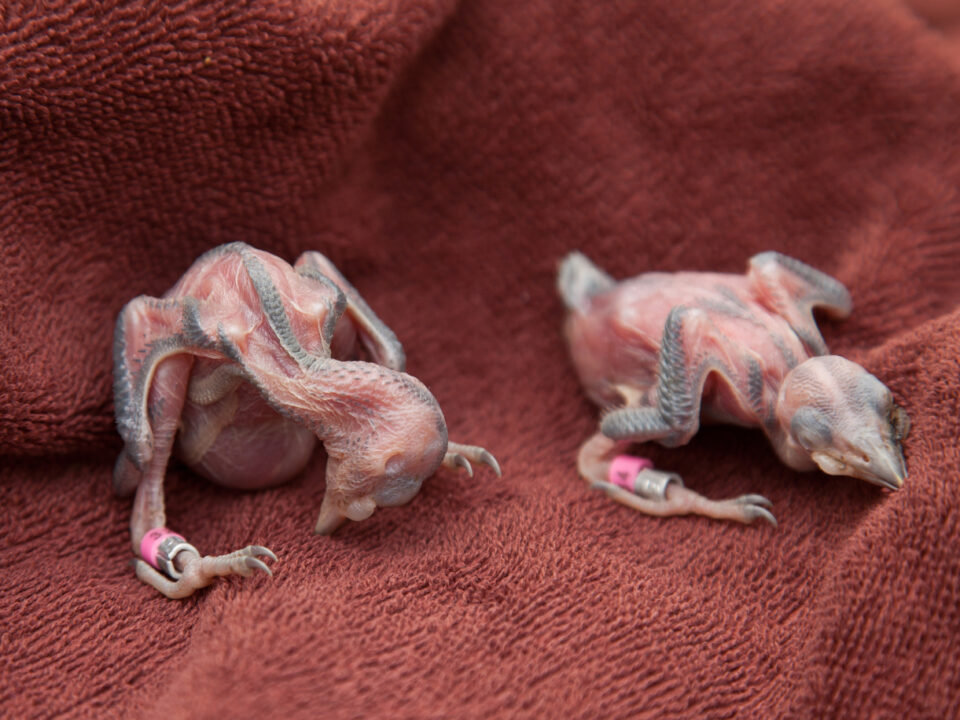Ipswiches cope after Jonas

Grace Spends Week at Research Station 3/31/2016
April 4, 2016Studying the Red Knot in Coastal Georgia
April 4, 2016
On Friday, January 22nd the squeeze play between a rare winter tropical storm named Jonas moving north along the Atlantic Coast and a high pressure ridge over eastern Canada created battering winds within the mid-Atlantic. By 3:00 a.m. on Saturday sustained onshore winds of 50 mph and gusts above 80 mph stood up offshore waves to a height of over 25 feet. This storm caused widespread property damage across several states and reworked the landscape of the Virginia Barrier Islands. A standing question for decades is how do resident birds that depend on this landscape cope with such storms?
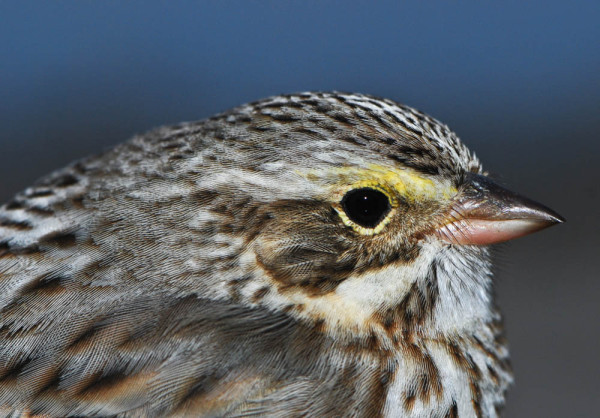
Exquisitely marked Ipswich sparrow showing bright white feathers during winter. Photo by Bryan Watts.
Fall and winter storms are the agents of change within this dynamic barrier island landscape. The forces of water and wind move tremendous volumes of sand overtop dunes and set back the successional clock. Succession will begin anew, building dunes that lead to grassland, then to shrubland, and ultimately to maritime forest. This alternating process of damage and repair is critical to several breeding bird species, like the federally threatened piping plover and the declining least tern that depend on open beaches for nesting. But the season of residency for these breeding birds is opposite of the storms, with storms occurring in the fall and winter and breeding occurring in the spring and summer. Very little is known about how the winter bird community copes with these storms and their aftermath.
The Ipswich sparrow is a geographically isolated subspecies of the savannah sparrow. The Ipswich is a true coastal sparrow, spending its entire lifecycle in dune habitat along the Atlantic Coast. Its breeding range is restricted to Sable Island off the coast of Nova Scotia, Canada, where it nests in dune and heath habitat. Its primary winter habitat includes coastal barriers and beaches along the Atlantic Coast. The global population is estimated to be only 6,000 individuals. Although a considerable body of research has been completed on the breeding grounds, very little is known about the winter ecology of this unusual bird.
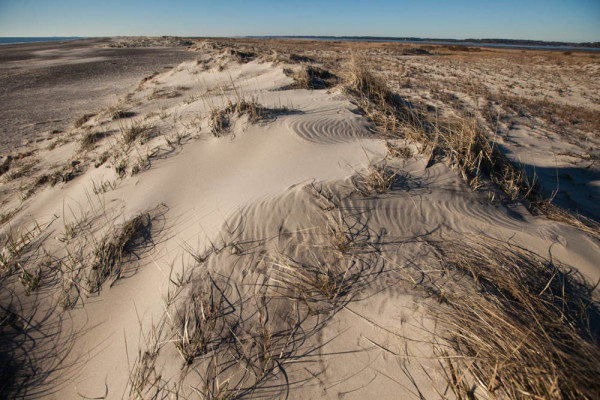
Looking south down the primary dune line. To the left is the active beach zone of the island. To the right is the hind-dune grassland that represents the typical habitat used by the Ipswich sparrow in winter. Photo by Bryan Watts.
On January 30th, just seven days after the passage of Jonas, Bryan Watts, Fletcher Smith, Ned Brinkley, and Todd Day traveled out to Metomkin Island to survey Ipswiches. Over the past several years, CCB has determined that Metomkin is the center of abundance for Ipswiches along the Virginia Barrier Islands (read about our visit to the island in the winter of 2014-2015). The site supports the largest contiguous patch of preferred habitat in the state. On this day we surveyed the 5.8-kilometer (3.6-mile) patch of habitat extending north from the south end of the island and recorded 115 Ipswich sparrows, 111 regular savanna sparrows, 12 horned larks, 10 northern harriers, 6 eastern meadowlarks and 4 lapland longspurs. Incredibly, the number of Ipswich sparrows counted is nearly identical to the 117 counted by Bryan Watts and Dana Bradshaw within the same patch in 2011.
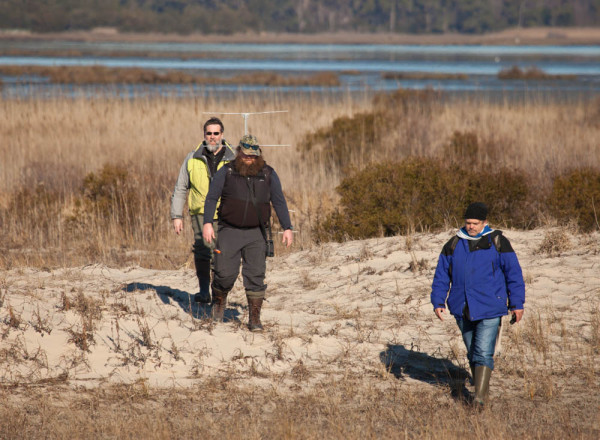
Todd Day (lft), Fletcher Smith (m) and Ned Brinkley (rt) scour the back side of Metomkin Island for Ipswich sparrows. Photo by Bryan Watts.
The trip to Metomkin offered a rare opportunity to examine barrier island habitats shortly after a major storm and to observe Ipswich response to changes. Despite the fact that the birds continued to be present on the island, their distribution and pattern of habitat use was dramatically different than during previous visits. In previous years, Ipswiches were mostly confined to the open dunes, overwash fans and hind-dune grasslands where the birds are easily camouflaged by their sand-colored plumage and foraged singly or in small groups. On this visit, most birds were compressed along the shrub line and were using dense vegetation.
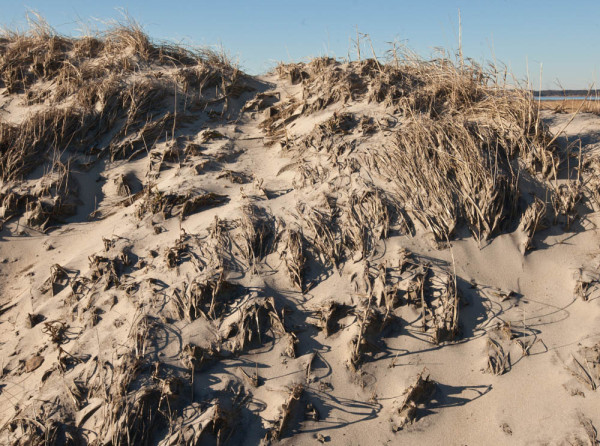
A section of dune that was sand blasted with wet sand during winter storm Jonas, burying and matting down much of the dune grass. Photo by Bryan Watts.
Upon inspection, it appeared that much of the grass and forb vegetation on the dunes and within the dune swales had been sand blasted, stripping and burying the seeds. It is possible that the entire year’s seed crop was lost in the storm leaving the birds to adjust and behave like their regular savanna cousins. Maintaining flexibility and having a “plan B” may be the key to survival within this raw and dynamic landscape during the winter months.
GALLERY:
[easy_image_gallery]
Written by Bryan Watts | bdwatt@wm.edu | (757) 221-2247
April 2, 2016
Related posts
Adult female from Elkins Chimney territory. Both the female and male were lost from this site between 2024 and 2025 nesting seasons and were not replaced. This territory has been occupied since 1995. Five territories were vacated between 2024 and 2025 along the Delmarva Peninsula in VA. Photo by Bryan Watts

